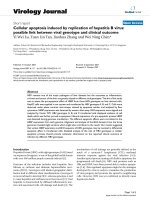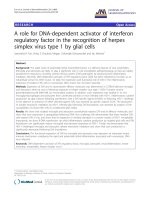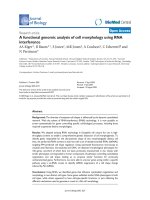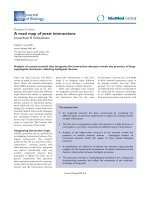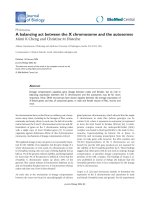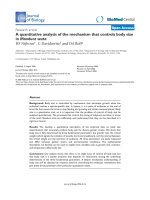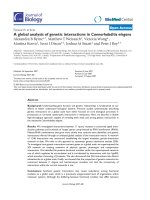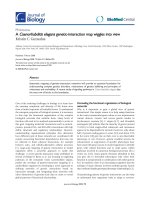Báo cáo sinh học: "A dual function fusion protein of Herpes simplex virus type 1 thymidine kinase and firefly luciferase for noninvasive in vivo imaging of gene therapy in malignant glioma" ppsx
Bạn đang xem bản rút gọn của tài liệu. Xem và tải ngay bản đầy đủ của tài liệu tại đây (1.71 MB, 13 trang )
BioMed Central
Page 1 of 13
(page number not for citation purposes)
Genetic Vaccines and Therapy
Open Access
Research
A dual function fusion protein of Herpes simplex virus type 1
thymidine kinase and firefly luciferase for noninvasive in vivo
imaging of gene therapy in malignant glioma
Ariane Söling*
1
, Christian Theiß
1
, Stephanie Jungmichel
1
and
Nikolai G Rainov
1,2
Address:
1
Molecular Neurooncology Laboratory, Dept. Neurosurgery, Martin-Luther-University Halle-Wittenberg, 06097 Halle, Germany and
2
Dept. Neurological Science, University of Liverpool, Liverpool 9L 7LJ, United Kingdom
Email: Ariane Söling* - ; Christian Theiß - ;
Stephanie Jungmichel - ; Nikolai G Rainov -
* Corresponding author
gliomabioluminescence imaginggene therapyherpes simplex virus type 1 thymidine kinaseluciferase
Abstract
Background: Suicide gene therapy employing the prodrug activating system Herpes simplex virus
type 1 thymidine kinase (HSV-TK)/ ganciclovir (GCV) has proven to be effective in killing
experimental brain tumors. In contrast, glioma patients treated with HSV-TK/ GCV did not show
significant treatment benefit, most likely due to insufficient transgene delivery to tumor cells.
Therefore, this study aimed at developing a strategy for real-time noninvasive in vivo monitoring of
the activity of a therapeutic gene in brain tumor cells.
Methods: The HSV-TK gene was fused to the firefly luciferase (Luc) gene and the fusion construct
HSV-TK-Luc was expressed in U87MG human malignant glioma cells. Nude mice with subcutaneous
gliomas stably expressing HSV-TK-Luc were subjected to GCV treatment and tumor response to
therapy was monitored in vivo by serial bioluminescence imaging. Bioluminescent signals over time
were compared with tumor volumes determined by caliper.
Results: Transient and stable expression of the HSV-TK-Luc fusion protein in U87MG glioma cells
demonstrated close correlation of both enzyme activities. Serial optical imaging of tumor bearing
mice detected in all cases GCV induced death of tumor cells expressing the fusion protein and
proved that bioluminescence can be reliably used for repetitive and noninvasive quantification of
HSV-TK/ GCV mediated cell kill in vivo.
Conclusion: This approach may represent a valuable tool for the in vivo evaluation of gene therapy
strategies for treatment of malignant disease.
Background
Treatment with the suicide gene/ prodrug activating sys-
tem herpes simplex virus type I thymidine kinase/ ganci-
clovir (HSV-TK/ GCV) is highly efficient in animal models
Published: 04 August 2004
Genetic Vaccines and Therapy 2004, 2:7 doi:10.1186/1479-0556-2-7
Received: 05 April 2004
Accepted: 04 August 2004
This article is available from: />© 2004 Söling et al; licensee BioMed Central Ltd.
This is an open-access article distributed under the terms of the Creative Commons Attribution License ( />),
which permits unrestricted use, distribution, and reproduction in any medium, provided the original work is properly cited.
Genetic Vaccines and Therapy 2004, 2:7 />Page 2 of 13
(page number not for citation purposes)
of malignant glioma [1-3]. In contrast, clinical trials
employing the HSV-TK/ GCV system and a retroviral vec-
tor have demonstrated only a limited effect in glioblast-
oma patients [4-8], implying that transfer and
distribution of the transgene in human brain tumors were
very low in vivo and differed obviously from the findings
in animal experiments. Presently, the standard method
for assessing delivery of therapeutic transgenes to tumors
relies on ex vivo analysis of explanted tumor tissue
[7,9,10]. Time course analysis of transgene expression
thus requires a multitude of animals to be sacrificed. In
the past few years, noninvasive imaging techniques such
as positron emission tomography (PET), magnetic reso-
nance imaging, and optical imaging methods using fluo-
rescence and bioluminescence were introduced and
increasingly used for temporal and spatial monitoring of
transgene expression [11-13].
Bioluminescence imaging (BLI) using luciferase (Luc)
from the North American firefly Photinus pyralis as a
reporter has several advantages compared to other imag-
ing methods: (1) the technique is very sensitive (possibly
10
-15
– 10
-17
mole of luciferase/L are detectable in vivo,
[13]) and detects tumor cells at a stage where radiography
and PET cannot [14,15], (2) bioluminescence imaging
using a cooled CCD camera does not require great techni-
cal expertise and (3) it is faster and less expensive than
many other imaging techniques. Furthermore, in contrast
to fluorescence imaging, where autofluorescence may
interfere with the signal of interest [13], background lumi-
nescence is negligible.
This study aimed at generating a sensitive tool for nonin-
vasive in vivo monitoring of the activity of a therapeutic
transgene by fusing the bioluminescent reporter gene Luc
to the bioactivating "suicide" gene HSV-TK. We investi-
gated whether this fusion construct could be used to mon-
itor HSV-TK mediated cytotoxicity in malignant glioma by
serial optical imaging in vivo. Noninvasive real time eval-
uation of localization, activity and persistence of a thera-
peutic gene in living animals may represent an important
step towards optimization of gene therapy protocols.
Methods
Vector construction
The HSV-TK cDNA from the retroviral vector G1Tk1SvNa
([16], kind gift from E. Otto, GTI Inc., Gaithersburg, MD)
and the "humanized" firefly luciferase (Luc) gene from the
pGL3 vector (Promega) were ligated into pCDNA 3.1(-)
(Invitrogen). For the fusion construct, EGFP in the pEGF-
PLuc vector (BD Biosciences) was exchanged for HSV-TK
cDNA, which had been amplified from G1Tk1SvNa by
PCR. The resulting HSV-TK-Luc fusion gene contained a
humanized form of the firefly Luc gene to ensure high
expression in mammalian cells [17]. The full length HSV-
TK cDNA was inserted in frame upstream of the Luc
cDNA, and both genes were separated by a linker
sequence of 33 nucleotides. All transgenes were expressed
under the control of the CMV promoter. The correct
sequence of the fusion construct HSV-TK-Luc was con-
firmed by DNA sequencing.
Cell culture and transfection
The human glioblastoma cell lines U87MG, T98G, LN18,
U343, LN-Z308 and human embryonic kidney 293 cells
were cultured under standard conditions. Cells were
seeded in 6-well plates at a density of 3 – 5 × 10
5
cells/ well
16 to 24 h prior to transfection. Cells were transfected
under serum-free conditions with the indicated amounts
of DNA and Lipofectamine (Invitrogen) according to the
manufacturer's protocol. For selection of stable clones
transfected cells were replated at low density 48 h after
transfection and incubated with 1 mg/ml (final concen-
tration) geneticin (Calbiochem, Bad Soden, Germany) for
4 weeks. Colonies were picked and analyzed for transgene
expression.
Cytotoxicity assay
Transiently or stably transfected U87MG cells were seeded
at 4 × 10
3
cells/ well in a 96-well plate. GCV was added at
final concentrations of 0 – 10 µg/ml and cells were incu-
bated at 37°C/ 5% CO
2
for 4 days. MTT (Sigma, Deisen-
hofen, Germany) was added at a final concentration of 0.5
mg/ml for 2 h. Absorbance was measured in a microplate
reader (Victor2, Perkin Elmer Life Sciences, Turku, Fin-
land) at 590 nm (reference 660 nm). Experiments were
performed in quadruplicates and repeated at least twice.
Results are reported along with the standard deviation
(SD).
Cell culture assays for luciferase activity
Transiently transfected U87MG cells were lysed in CCLR
lysis buffer (Promega) 2 days after transfection. Stably
transfected cells were lysed in the same buffer when they
had reached ~90% confluence. Protein content of all cell
lysates was determined by the Bradford Protein assay
(Bio-Rad, Munich, Germany). Equal amounts of protein
were analyzed luminometrically for luciferase activity
with a microplate reader (Victor2) using the Luciferase
Assay System reagent (Promega). All experiments were
repeated at least twice and mean values are reported along
with the SD.
For bioluminescence imaging of intact cells HSV-TK-Luc
expressing U87 glioma cells were transferred to a black
microtiter plate in order to minimize light scattering, and
MTT assay was performed in quadruplicates as described
above. On day 4 after addition of GCV, D-Luciferin was
added to a final concentration of 500 µM to the culture
medium. Cells were placed in a dark box and light
Genetic Vaccines and Therapy 2004, 2:7 />Page 3 of 13
(page number not for citation purposes)
emission was imaged using a cooled CCD camera (Vis-
iluxx Imager, Visitron). Light emitted from a region of
interest (ROI) drawn over each well was quantified and
mean values from quadruplicate measurements were
compared with MTT results.
Immunohistochemistry and Hematoxylin-Eosin (HE)
staining
Immunohistochemistry on paraffin sections using a rab-
bit polyclonal anti-Luc antibody (CR2029RAP, Europa
Bioproducts) was performed essentially as described by
Lee et al [18]. HE staining was performed according to
standard protocols.
Animal experiments
All animal protocols were approved by the Animal Care
and Use Committee at Martin-Luther-University Halle-
Wittenberg. Six week old male NMRI nu/nu mice (Charles
River) were injected s.c. at four sites, each with 2 × 10
6
human U87MG glioma cells stably expressing the HSV-
TK-Luc fusion protein. When xenografts had reached a
size of ~5 mm in diameter, in general on days 7 to 9 post
tumor implantation GCV therapy was initiated. Mice were
injected twice daily i.p. with 30 mg/ kg GCV for 14 days.
Control mice with xenografts (n = 3) received saline injec-
tions. Tumor size was measured every 2 to 4 days by cali-
per. Tumor volume was calculated according to the
formula 0.52 × width
2
× length.
Bioluminescence imaging
For BLI animals were anesthetized with ketamine/xyla-
zine and injected i.p. with 150 mg/ kg D-Luciferin.
Approximately 8 minutes after D-Luciferin injection mice
were placed in a dark box and a grayscale image was
acquired at low light (exposure time 2 seconds). Biolumi-
nescence was measured in the dark by a CCD camera
cooled to -120°C (VisiLuxx Imager), using an acquisition
time of 15 min and binning 6. Bioluminescent signals
were displayed in pseudocolors and superimposed on the
grayscale image using Metamorph software (Visitron).
Mice receiving GCV were imaged at least on days 7, 15, 22,
29, and 56 post tumor implantation (corresponding to
start and day 8 of GCV therapy, as well as days 1, 8, and
35 after end of GCV therapy), while untreated control ani-
mals were subjected to BLI on days 7, 22, 29 and 35. In
each animal a region of interest (ROI) was drawn over a
single tumor or over all tumors as indicated in the text.
Integrated as well as maximum light units (= counts)
within this area were calculated after background subtrac-
tion. Final values are reported as the mean of the inte-
grated or maximum counts obtained from all mice within
one group. The CCD camera in use has a quantum effi-
ciency approaching 90% at wavelengths between 550 and
770 nm, indicating that one photon is converted to ~0.9
electrons. One photoelectron corresponds to 4.52 counts.
For serial quantification of light emission the conditions
for image acquisition (e.g. exposure time, time between
D-Luciferin application and image acquisition, stage posi-
tion) were kept constant.
Statistics
Statistical analysis was performed using the ANOVA and
Student's t test (SPSS and Microcal Origin Software). A p
value of <0.05 was considered significant.
Results
Characterization of the HSV-TK-Luc fusion construct
To achieve a strictly equimolar coexpression of a thera-
peutic and a reporter gene, the HSV-TK cDNA was fused in
frame with the Luc cDNA in 2 ways: one fusion protein
contained HSV-TK N-terminally, in the other construct
Luc preceded the HSV-TK moiety. Both constructs were
expressed under control of the CMV promoter. Several
human glioma cell lines as well as 293 cells were tran-
siently transfected with these constructs. In general, Luc
activity was found to be up to 50-fold higher in cells
expressing the HSV-TK-Luc construct compared to cells
expressing the Luc-HSV-TK construct (data not shown).
Therefore, all further studies were performed with the
HSV-TK-Luc fusion construct.
In order to characterize this fusion construct more thor-
oughly, both transient and stable transfection experi-
ments were performed using the human U87MG glioma
cell line (Figures 1 and 2). For transient transfection exper-
iments, cells were transfected with 50 ng (~11.2 fmol) – 2
µg (~450 fmol) of plasmid DNA harboring either HSV-
TK, Luc, or HSV-TK-Luc transgenes, respectively. As all 3
vectors were of equal size, equal amounts of DNA corre-
sponded to equimolar amounts of plasmid. Cytotoxic
activity as measured by MTT assay was compared to lumi-
nometrically determined light production and found to
be tightly correlated in HSV-TK-Luc transfected cells (Fig-
ure 1, R
2
= 0.99; p < 0.0001). Photon emission above
background levels was not detectable in cells that had
been transfected with HSV-TK only, while no cytotoxic
activity was conferred to cells expressing only Luc.
Cytotoxic and Luc activity in cells transiently transfected
with the HSV-TK-Luc fusion construct were also compared
to the respective activities in cells transiently transfected
with equimolar amounts (50 ng – 2 µg DNA) of HSV-TK
or Luc alone. The overall cytotoxic activity of the fusion
construct proved to be 60% of that measured in cells
transfected with HSV-TK alone. Representative curves for
2 µg and 0.1 µg of transfected DNA are shown in Figure
2A. Luc activity of the fusion protein was also lower com-
pared with native Luc: light production in cells transfected
with HSV-TK-Luc was 22% of that seen in cells transfected
with Luc only (Figure 2B). A tight linear correlation of
Genetic Vaccines and Therapy 2004, 2:7 />Page 4 of 13
(page number not for citation purposes)
bioluminescence to cell kill was achieved with the fusion
protein, suggesting that light emission can indeed be used
as a measure for the cytotoxic effect of transgenic HSV-TK.
Stable expression of the HSV-TK-Luc fusion gene in human
glioma cells
Having demonstrated in transient transfection experi-
ments that Luc could be employed as a reporter for mon-
itoring the therapeutic effect of HSV-TK, U87MG cell
clones stably expressing the HSV-TK-Luc fusion protein
were generated by selection of transfected cells with
geneticin. Comparison of 18 of these clones for Luc and
cytotoxic activity revealed a good correlation between
both enzymatic activities (R
2
= 0.79; p < 0.001, data not
shown).
Enzymatic activity in the U87MG clone with both the
highest Luc and HSV-TK activity was compared with
Cytotoxic and bioluminescent activity in U87MG glioma cells transiently transfected with different amounts of HSV-TK-Luc plas-midFigure 1
Cytotoxic and bioluminescent activity in U87MG glioma cells transiently transfected with different amounts of HSV-TK-Luc plas-
mid. (A) Cytotoxic activity as measured by MTT assay and (B) luciferase activity as determined luminometrically in cell lysates.
Results are displayed as counts per second (cps)/ µg protein. (C) Linear regression analysis of cytotoxic activity plotted against
luciferase activity for the different amounts of plasmid DNA. Results from 3 independent experiments were used.
Comparison of the enzymatic activities of the HSV-TK-Luc fusion protein, HSV-TK, and LucFigure 2
Comparison of the enzymatic activities of the HSV-TK-Luc fusion protein, HSV-TK, and Luc. U87MG cells were transiently
transfected with 0.05 – 2 µg of HSV-TK-Luc, Luc, or HSV-TK plasmid. Cells transfected with equimolar amounts of DNA were
analyzed for cytotoxic and bioluminescent activity. (A) Cytotoxic activity of cells transfected with HSV-TK-Luc or HSV-TK. For
reasons of clarity only the graphs for 0.1 µg and 2 µg of transfected DNA are shown. (B) Luciferase activity in U87MG cells
transfected with HSV-TK-Luc or Luc only. Results represent 3 independent experiments.
Genetic Vaccines and Therapy 2004, 2:7 />Page 5 of 13
(page number not for citation purposes)
U87MG clones expressing unfused HSV-TK or Luc. Cells
stably expressing HSV-TK did not luminesce upon addi-
tion of D-Luciferin while Luc expressing cell clones were
resistant to GCV mediated cell killing (data not shown).
The dual function fusion protein compared favorably to
the respective clones with the highest HSV-TK or Luc activ-
ity. Light production in the HSV-TK-Luc expressing cell
clone was ~41% of that seen in Luc expressing U87MG
cells while cytotoxic activity of the HSV-TK-Luc labeled
U87MG clone was ~84% of that seen with the most active
HSV-TK expressing U87MG clone (data not shown). Pho-
ton emission determined luminometrically was found to
be linearly correlated with cell number over a range of at
least 5 orders of magnitude (R
2
= 0.99; p < 0.001, data not
shown). Photon emission from as few as 500 intact cells
expressing the fusion construct was detectable by the CCD
camera while the lower detection limit for the Luc express-
ing U87MG cell clone was 125 cells.
We further examined whether the cytotoxic activity of the
HSV-TK moiety could be visualized by monitoring light
emission from intact cells that had been treated with GCV
at different concentrations. Signals captured by the CCD
camera showed a close correlation to the cytotoxic effect
as measured by MTT assay (Figure 3, R
2
= 0.94; p = 0.029).
These data demonstrate that both enzyme activities were
also preserved in U87MG cells stably expressing the HSV-
TK-Luc fusion construct.
Correlation of HSV-TK with luciferase activity in vivo
The above high expresser U87MG cell clone was used for
xenograft experiments in nude mice. For sensitivity test-
ing, 2 × 10
3
, 2 × 10
4
and 2 × 10
5
cells were injected s.c. on
the back of the animals. Although not palpable, 2 × 10
4
cells expressing the fusion construct were detected by the
CCD camera immediately after injection (= day 0), either
when injected alone or mixed with 1.8 × 10
5
(90%) non-
luminescent parental U87MG cells prior to injection,
while 2 × 10
3
cells injected s.c. were not seen (data not
shown). This high level of detectability by BLI proves the
usefulness of the HSV-TK-Luc construct as a highly sensi-
tive reporter in vivo.
For therapeutic studies, mice received injections with 2 ×
10
6
HSV-TK-Luc labeled U87MG cells at four different
sites on the back and the flanks, respectively (Figure 4).
When tumors had reached a size of ~5 mm in diameter, a
bioluminescence image was acquired and GCV therapy
was initiated (n = 7). GCV treatment did not cause any sig-
nificant toxicity and treated mice displayed normal pat-
terns of food intake and physical activity. Control animals
(n = 3) received saline injections. Initial tumor volumes in
all mice were 309 ± 37 mm
3
and light intensity units (=
counts) measured on day 7 were 122961 ± 22155. Serial
measurements (during and after GCV therapy) of tumor
volumes and integrated light intensity units within a
region of interest (ROI) including all tumors were plotted
against each other (Figure 5). Within the 2 weeks of GCV
treatment, all 7 mice showed a rapid decline in photon
emission from their tumors (mean decrease: 92 ± 7%, Fig-
ure 5A), which was accompanied by a somewhat slower
decrease in tumor volume (65 ± 19%, Figure 5B). A linear
regression analysis of mean tumor volumes in treated
mice on days 7, 15, 22, 29, and 56 post tumor implanta-
tion plotted against the respective mean integrated light
units is displayed in Figure 6A. Light emission and tumor
Correlation of light emission with cytotoxicity in intact U87MG glioma cells stably expressing the HSV-TK-Luc fusion construct and treated with GCVFigure 3
Correlation of light emission with cytotoxicity in intact U87MG glioma cells stably expressing the HSV-TK-Luc fusion construct
and treated with GCV. (A) Cytotoxic activity as determined by MTT assay. (B) Bioluminescence imaging of quadruplicates of
intact U87MG cells treated with the indicated amounts of GCV or left untreated (control). (C) Linear regression analysis of
photon emission detected by the CCD camera plotted against cytotoxicity (R
2
= 0.94; p = 0.029).
Genetic Vaccines and Therapy 2004, 2:7 />Page 6 of 13
(page number not for citation purposes)
volumes correlated closely with each other (R
2
= 0.93; p =
0.008), thus confirming our cell culture data (Figures 1
and 3).
Regarding therapeutic efficacy in these mice on an indi-
vidual basis, photon emission and tumor volumes
showed a significant correlation, with R
2
values ranging
from 0.78 to 0.96 and p ranging from 0.004 to 0.047,
except for one mouse (R
2
= 0.731; p= 0.065). In this
mouse a significant correlation between light emission
and tumor volume could be demonstrated, when tumor
volumes were plotted against the maximum light emission
within a ROI (R
2
= 0.81; p = 0.037) instead of integrated
light units. In general, integrated light units within a ROI
correlated closely with maximum light emission from this
ROI: correlation coefficients (R
2
) for all tumors in treated
mice varied between 0.97 and 0.99, all p values were
<0.003.
Five weeks after end of GCV therapy (day 56) light emis-
sion was no longer detectable in 5 of the 7 GCV-treated
mice, while in 4 of them small residuums at the tumor site
were still visible. Two mice still showed very weak light
emission from one of their flank tumors which also
disappeared in subsequent imaging studies. All GCV
Bioluminescence imaging of nude mice carrying HSV-TK-Luc expressing U87MG gliomasFigure 4
Bioluminescence imaging of nude mice carrying HSV-TK-Luc expressing U87MG gliomas. (A) Serial images from a mouse with
4 s.c. xenografts treated with GCV from day 7 to day 21 post tumor implantation and (B) saline treated control mouse, sacri-
ficed on day 35 post tumor implantation due to massive tumor growth. The largest tumor in this mouse on the upper right
back has already become necrotic. The day 35 image is also displayed at a broader grayscale range for better visualization of
tumor localization. Note that control tumors also showed decreased light emission and a reduction in tumor size within the
first 3 weeks post tumor implantation.
Genetic Vaccines and Therapy 2004, 2:7 />Page 7 of 13
(page number not for citation purposes)
Comparison of (A) bioluminescence signals detected by the CCD camera and (B) tumor volumes in GCV-treated mice (n= 7, M1 – M7) harboring HSV-TK-Luc tagged U87MG glioma xenograftsFigure 5
Comparison of (A) bioluminescence signals detected by the CCD camera and (B) tumor volumes in GCV-treated mice (n= 7,
M1 – M7) harboring HSV-TK-Luc tagged U87MG glioma xenografts. GCV (60 mg/kg per day) was administered for 14 days
starting at day 7 post tumor implantation. All mice were imaged at least on days 7, 15, 22, 29, and 56 post tumor implantation.
BLI signals and tumor volumes at the beginning of therapy were set as 100%. Identical symbols in both graphs correspond to
identical animals.
Linear regression analysisFigure 6
Linear regression analysis. Light emission as determined by the CCD camera was plotted against tumor volume. Mean values
for all animals in a group along with the S.E.M are reported. (A) GCV treated mice: mice (n = 7) were imaged at start of ther-
apy, after 1 and 2 weeks of GCV treatment, and 1 and 5 weeks after end of GCV therapy (R
2
= 0.93, p = 0.008). In some mice
additional images were acquired (Figure 5), but these were not included in this plot. (B) Saline treated control mice: these mice
(n = 3) were imaged on days 7, 22, 29, and 35 and were sacrificed after the last BLI due to massive tumor growth (R
2
= 0.98, p
= 0.010).
Genetic Vaccines and Therapy 2004, 2:7 />Page 8 of 13
(page number not for citation purposes)
Ex vivo bioluminescence imaging and histological analysis of a large HSV-TK-Luc tagged U87MG glioma in a control mouseFigure 7
Ex vivo bioluminescence imaging and histological analysis of a large HSV-TK-Luc tagged U87MG glioma in a control mouse. (A)
Bioluminescence image (exposure time 10 min) of the freshly explanted tumor after D-Luciferin injection in the mouse prior to
sacrifice. The tumor was cut in the middle and placed with the cut side facing the CCD camera. One part of the tumor was
obviously hemorrhagic while the other part looked vital. Photon emission displayed in pseudocolors precisely reflected the
macroscopic findings. (B, a and b) HE staining of paraffin sections from the same tumor as seen in (A) vital tumor region (a);
hemorrhagic and necrotic tumor area (b); (B, c and d) immunohistochemistry on corresponding sections using a polyclonal
anti-Luc antibody; vital tumor area (c) and hemorrhagic and necrotic region (d) with only scarce positive staining. Original mag-
nification × 400.
Genetic Vaccines and Therapy 2004, 2:7 />Page 9 of 13
(page number not for citation purposes)
treated mice survived and tumor recurrence was not
observed until closure of the study at day 90 post tumor
implantation.
The 3 untreated control mice were imaged on days 7, 22,
29, and 35 post tumor implantation and had to be sacri-
ficed on weeks 5 to 6 post cell injection due to massive
tumor growth. Although 2 tumors with relatively strong
light emission on day 7 post tumor implantation
regressed within 4 weeks in one of the control mice, over-
all tumor growth in all control animals plotted against
light emission from these tumors still showed a tight cor-
relation (R
2
= 0.98; p = 0.010; Figure 6B). Within 4 weeks,
tumor volumes increased by ~11-fold while photon emis-
sion concomitantly rose ~6-fold. When tumors had
become very large (>12–15 mm in diameter) further
increase in light emission was much less than the increase
in volume. This was mirrored by a less stringent linear cor-
relation of BLI signal and tumor size in large tumors.
The control mouse shown in Figure 4B serves as an exam-
ple: on day 35 the tumor on the right upper back shows
an attenuated bioluminescent signal although being the
largest tumor. While linear regression analysis demon-
strated a very good correlation of tumor volume to light
emission for the other 3 tumors (R
2
= 0.99 and p = 0.002
for tumors on the back and the right flank; R
2
= 0.98 and
p = 0.011 for the tumor on the left flank), R
2
was 0.90 (p
= 0.050) for this large tumor. When serially determined
maximum light emission was used for quantification in
this particular tumor, R
2
dropped to 0.37 (p = 0.4).
When control mice were sacrificed, tumors were
explanted, and immediately reimaged. Bioluminescence
imaging confirmed reduced light emission from hemor-
rhagic and necrotic areas in large tumors (Figure 7A).
Immunohistochemical analysis of these tumor regions
using a polyclonal anti-Luc antibody also showed a rela-
tively scarce positive staining of necrotic areas as com-
pared to areas with strong photon emission (Figure 7B).
Discussion
This study demonstrates that firefly luciferase is a valuable
tool for monitoring noninvasively the efficacy of the pro-
drug activating system HSV-TK/ GCV in cell culture and in
vivo. The HSV-TK-Luc fusion protein was successfully used
in a brain tumor animal model for serial and sensitive real
time quantification of the cytotoxic effect of HSV-TK by
BLI.
Correlation of enzymatic activities
Fusion of two enzymes is the only way to guarantee stoi-
chiometric, and thus correlated expression of both fusion
partners. We chose this approach because coexpression of
two separate transgenes from either one or separate pro-
moters has been reported to result in severely impaired
gene expression, e.g. due to inefficient internal ribosome
entry site (IRES)-mediated translation [19] or to promoter
interference [20].
The HSV-TK protein contains several nuclear targeting sig-
nals and is usually located predominantly in the nucleus
[21]. The enzyme may form a homodimer, and it has been
proposed that only dimeric HSV-TK is transported to the
nucleus [21]. On the other hand, in the commercially
available firefly Luc we have used, the peroxisomal
targeting sequence present in wild type Luc has been
removed to ensure strict cytosolic compartmentalization,
and thus reliable reporter function [17]. Fusing both
enzyme moieties together resulted in a protein with pre-
dominant localization in the cytosol, as shown by the
immunohistochemical analysis of HSV-TK-Luc expressing
glioma cells (Figure 7B). In contrast, we have shown pre-
viously that fusion of the 27 kDa protein EGFP to HSV-TK
allowed for predominant nuclear transfer of the enzyme
while resulting in only minor loss of cytotoxic activity
[22], suggesting that cytosolic localization and/ or
reduced homodimer formation of the HSV-TK-Luc fusion
protein may have some impact on its cytotoxic activity.
A decrease in HSV-TK activity of up to 80% compared to
unfused HSV-TK has also been observed by Ray et al.
when fusing the enzyme to Renilla Luc [23]. N2A neurob-
lastoma cells harboring the fusion construct could be
detected by PET and BLI in nude mice, but the cytotoxic
activity of HSV-TK was not examined in the study. Renilla
Luc activity in the above construct was found to be ~6 – 8-
fold higher than seen with its unfused counterpart. As this
enzyme is structurally unrelated to firefly Luc and has a
lower molecular weight (36 kDa vs. 62 kDa), the study
cannot be directly compared to our data. Notably, the
authors mention that their attempt to fuse HSV-TK to fire-
fly Luc resulted in a "poorly active" fusion protein [23].
Recently, the generation of several triple fusion proteins
for imaging with different modalities was reported by two
groups [24,25]. These triple reporters consisted of wild
type or mutated HSV-TK, a fluorescent protein (EGFP,
DsRed2, or monomeric red fluorescent protein (mRFP))
and firefly Luc [24,25] or Renilla Luc [25], respectively.
Both groups showed that such triple fusion constructs
could be used for simultaneous imaging in vivo with bio-
luminescence, fluorescence, and PET. Cytotoxicity gener-
ated by enzymatic conversion of prodrug by HSV-TK was
however not measured in either of the above studies.
Ponomarev et al. [24] did not present data on the corre-
lated expression of the three reporters within the triple
fusion protein (HSV-TK-EGFP-Luc), nor were the activity
levels of the different fusion partners compared to those
Genetic Vaccines and Therapy 2004, 2:7 />Page 10 of 13
(page number not for citation purposes)
of their unfused counterparts. Despite these limitations,
the study confirms that Luc remains functional if fused N-
terminally to other proteins, and that enzymatic activity is
sufficient for in vivo BLI.
Ray et al. [25] compared the enzymatic and fluorescent
activities of several triple fusion constructs transiently
transfected into 293 cells to the respective activities of the
unfused proteins. The described fusion proteins con-
tained either Renillla or firefly Luc at the NH
2
-terminus,
followed by a fluorescent protein and a mutated HSV-TK
enzyme. This orientation of the fusion partners as well as
the use of mutated HSV-TK optimized for use with PET
limits the direct comparison of the presented data to our
results. Bioluminescent activity of the 4 fusion constructs
containing firefly Luc was reduced to 22 – 63% of the
activity of unfused Luc, which is similar to our findings
when expressing HSV-TK-Luc in U87MG glioma cells.
One of the 4 constructs (Luc-mRFP-mutant HSV-TK) fully
retained HSV-TK PET reporter activity while in the others
HSV-TK activity (as assessed by intracellular radiotracer
accumulation) was reduced to 30 – 61% of the activity of
the corresponding unfused enzyme. This is in line with
our findings when expressing HSV-TK-Luc transiently in
U87MG glioma cells.
Although it seems attractive to perform BLI with different
luciferase enzymes, the following facts argue in favor of
firefly Luc instead of Renilla Luc: (1) light emission of
Renilla Luc peaks at 480 nm and thus shows only limited
tissue penetration, (2) coelenterazine, the Renilla Luc sub-
strate is prone to autoluminescence, resulting in high
background if injected i.p. [26], (3) coelenterazine trans-
port (and thus the bioluminescent signal) is modulated
by the multidrug resistance MDR1 P-glycoprotein, a pro-
tein known to be overexpressed in cancer cells [27], and
(4) coelenterazine is much more expensive than D-Luci-
ferin.
Iyer et al. [28] examined noninvasive imaging using PET
and BLI in CD-1 mice after simultaneous i.v. delivery of
the HSV-TK and Luc genes residing on different plasmids.
The time point of peak activity of both reporters differed
by ~19 hours, most likely due to differences in half lives
of the two enzymes. This finding supports our approach
of expressing both enzymes as one molecule as this
should greatly diminish differences in protein stability.
Attenuation of both enzymatic activities is most likely a
result of steric hindrance and might be substantially
reduced by selecting another linker sequence. Longer
intervening sequences as well as introduction of flexible
polyglycine linkers may contribute to an increase in
enzyme activity [23,29].
Recently, De et al. [15] introduced into a lentiviral vector
a mutant HSV-TK (optimized for PET imaging) and firefly
Luc, separated by an IRES sequence. N2a neuroblastoma
cells stably transduced with this construct and implanted
s.c. into nude mice showed correlated expression of both
enzymes as verified by PET and BLI (R
2
= 0.86). In contrast
to our study, GCV treatment in vivo resulted in a decrease
in light emission while the tumors continuously grew in
size. Most likely, this reflects the relatively poor cytotoxic
activity of the mutant HSV-TK used in these experiments,
implying that engineered HSV-TK optimized for use as a
PET reporter may not retain its full cytotoxic activity when
substrates such as GCV are used. Data on the cytotoxic
potential of the virus construct in cell culture were not
presented.
Cytotoxic effects of the fusion construct
We show here for the first time that a HSV-TK-Luc fusion
protein in conjunction with GCV treatment can confer a
curative effect on glioma bearing animals. While HSV-TK-
Luc expressing glioma cells in culture were not killed com-
pletely when using GCV concentrations of up to 10 µg/ml,
xenografts consisting of these cells were fully eliminated
in all GCV treated mice. It has been shown by several
groups that HSV-TK expressing tumor cells can elicit an
antitumor immune reaction even in immunocompro-
mised animals such as nude mice, most likely mediated
by natural killer (NK) cells, activated in vivo by GCV
induced cell killing [30,31]. We suggest that such an
immune response may also have contributed to the elim-
ination of HSV-TK-Luc expressing U87MG glioma cells in
GCV-treated mice. This issue could be further addressed
by in vivo depletion of NK cells through administration of
appropriate antibodies [30].
Optical detection of transgene expression
Our study used a subcutaneous glioma model for "proof
of concept" to allow for simultaneous bioluminescence
imaging and measurement of tumour size by caliper.
HSV-TK-Luc expressing U87MG glioma cells were also
detected by the CCD camera after inoculation of 2 × 10
6
cells intracerebrally in nude mice (data not shown), con-
firming the high sensitivity of BLI. Indeed, it has already
been demonstrated in a murine orthotopic pituitary
tumor model that bioluminescent light can travel through
skull [32].
The cooled CCD camera system we used allows for quan-
tification of emitted light. Some authors suggested that
the level of transgene expression could be more reliably
quantified by maximum light emission than by integrated
light units within a ROI [33]. Although quantification is
important if strategies for transgene delivery are to be
examined, a systematic comparison of these two parame-
ters in BLI has not been published until now. This
Genetic Vaccines and Therapy 2004, 2:7 />Page 11 of 13
(page number not for citation purposes)
prompted us to analyze these parameters in more detail in
our study.
If maximum and integrated light units within a ROI over
single tumors were compared, we consistently found that
both parameters tightly correlated with tumor size in
tumors up to ~1 cm in diameter. In larger tumors (maxi-
mum diameter examined = 2 cm) the increase in size was
in general less closely correlated with both integrated and
maximum light units, but light emission from a ROI
drawn over the entire tumor was still far more accurately
mirroring tumor growth than maximum light units emit-
ted from this region. With the increase in tumor thickness,
maximum light emission from the tumor core is reduced
due to necrosis, light scattering, and reduced supply of
oxygen and D-Luciferin to tumor cells. On the other hand,
the increase in tumor length and width is better reflected
by light signals integrated over the entire tumor area,
while a concomitant change in maximum light signal
does not necessarily have to occur. Therefore, integrated
light signals emitted from tumor ROIs seem to be the
measure of choice for serial imaging of transgene expres-
sion in growing tumors. The fact that tumor volume and
photon emission are less tightly correlated in large tumors
as compared to smaller ones implies that photon emis-
sion reflects mainly the presence of viable tumor cells
within a tumor and is a more precise measure for cytotoxic
efficacy than tumor size, as has also been suggested by
others [34,35].
Herpes simplex virus type I thymidine kinase has also
been used as a reporter gene for monitoring therapeutic
success with PET [11,36]. However, using optical imaging
methods to quantify transgene expression has several
advantages. The much greater sensitivity of BLI as com-
pared to PET (10
-15
– 10
-17
vs. 10
-11
– 10
-12
mole/L of
reporter probe are detectable, [13]) in combination with
very low background signals render this imaging method
particularly attractive for studying therapeutic strategies in
animal models of cancer. In addition, high costs, the need
for a radiopharmacy and considerable technical experi-
ence currently preclude widespread application of PET in
experimental gene therapy of cancer.
Conclusions
We showed that therapeutic efficacy of a suicide gene/
prodrug activating system can be accurately monitored in
vivo by BLI, when the bioluminescent reporter luciferase is
fused in frame to the therapeutic gene HSV-TK. We used a
clonal human glioma cell line stably expressing the HSV-
TK-Luc fusion construct, thus guaranteeing high level
transgene expression. Despite the somewhat attenuated
activity of both fusion partners, a high degree of cytotox-
icity by HSV-TK mediated GCV bioactivation as well as
strong bioluminescent signals upon administration of D-
luciferin were consistently demonstrated. In order to mir-
ror more closely in vivo gene therapy of malignant brain
tumors, experiments are underway to insert the HSV-TK-
Luc fusion gene (and an improved version of it) into
appropriate viral vectors and subsequently use them for
treatment of orthotopically established gliomas in mice.
Serial assessment of transduction levels, transgene locali-
zation and time course of fusion gene expression in living
animals by BLI can aid in developing more potent gene
therapy vectors for treatment of malignant glioma.
List of abbreviations
CCD, charged coupled device; CMV, cytomegalovirus;
cps, counts per second; EGFP, enhanced green fluorescent
protein; GCV, ganciclovir; HSV-TK, herpes simplex virus
type 1 thymidine kinase; Luc, luciferase; mRFP,
monomeric red fluorescent protein, PET, positron emis-
sion tomography; ROI, region of interest; SD, standard
deviation, SEM, standard error of the mean.
Competing interests
None declared.
Authors contributions
AS constructed the plasmids, performed the animal exper-
iments together with CT and set up the in vitro assays. CT
and SJ participated in the cell culture experiments and
enzymatic assays. SJ and AS carried out the immunohisto-
chemical studies. NGR and AS designed the experiments
and evaluated the data. All authors have read and
approved the manuscript.
Acknowledgements
We thank Hans-Dieter Söling for continuous support and critical com-
ments on the manuscript. The assistance of Roland Jacob in preparation of
the manuscript and Cornelia Gottschalk and Martina Hennicke in animal
care is gratefully acknowledged.
This work was supported by the Deutsche Forschungsgemeinschaft (grant
Ra 705/4-1 to NGR) and by the NBL3/ Wilhelm-Roux program (grant FKZ
2/36 to NGR and AS).
References
1. Ram Z, Culver KW, Walbridge S, Blaese RM, Oldfield EH: In situ
retroviral-mediated gene transfer for the treatment of brain
tumors in rats. Cancer Res 1993, 53:83-88.
2. Izquierdo M, Cortes M, de Felipe P, Martin V, Diez-Guerra J, Talavera
A, Perez-Higueras : Long-term rat survival after malignant
brain tumor regression by retroviral gene therapy. Gene Ther
1995, 2:66-69.
3. Mizuno M, Yoshida J, Colosi P, Kurtzman G: Adeno-associated
virus vector containing the herpes simplex virus thymidine
kinase gene causes complete regression of intracerebrally
implanted human gliomas in mice, in conjunction with gan-
ciclovir administration. Jpn J Cancer Res 1998, 89:76-80.
4. Ram Z, Culver KW, Oshiro EM, Viola JJ, DeVroom HL, Otto E, Long
Z, Chiang Y, McGarrity GJ, Muul LM, Katz D, Blaese RM, Oldfield EH:
Therapy of malignant brain tumors by intratumoral implan-
tation of retroviral vector-producing cells. Nat Med 1997,
3:1354-1361.
Genetic Vaccines and Therapy 2004, 2:7 />Page 12 of 13
(page number not for citation purposes)
5. Shand N, Weber F, Mariani L, Bernstein M, Gianella-Borradori A,
Long Z, Sorensen AG, Barbier N: A phase 1 – 2 clinical trial of
gene therapy for recurrent glioblastoma multiforme by
tumor transduction with the herpes simplex thymidine
kinase gene followed by ganciclovir. GLI 328 European-
Canadian study group. Hum Gene Ther 1999, 10:2325-2335.
6. Rainov NG: A phase III clinical evaluation of herpes simplex
virus type 1 thymidine kinase and ganciclovir gene therapy as
an adjuvant to surgical resection and radiation in adults with
previously untreated glioblastoma multiforme. Hum Gene Ther
2000, 11:2389-2401.
7. Harsh GR, Deisboeck TS, Louis DN, Hilton J, Colvin M, Silver JS,
Qureshi NH, Kracher J, Finkelstein D, Chiocca EA, Hochberg FH:
Thymidine kinase activation of ganciclovir in recurrent
malignant gliomas: a gene-marking and neuropathological
study. J Neurosurg 2000, 92:804-811.
8. Sandmair AM, Loimas S, Puranen P, Immonen A, Kossila M, Puranen
M, Hurskainen H, Tyynela K, Turunen M, Vanninen R, Lehtolainen P,
Paljarvi L, Johansson R, Vapalahti M, Yla-Herttuala S: Thymidine
kinase gene therapy for human malignant glioma, using rep-
lication-deficient retroviruses or adenoviruses. Hum Gene Ther
2000, 11:2197-2205.
9. Rainov NG, Kramm CM, Aboody-Guterman K, Chase M, Ueki K,
Louis DN, Harsh GR 4th, Chiocca A, Breakefield XO: Retrovirus-
mediated gene therapy of experimental brain neoplasms
using the herpes simplex virus-thymidine kinase/ ganciclovir
paradigm. Cancer Gene Ther 1996, 3:99-106.
10. Kruse CA, Roper MD, Kleinschmidt-DeMasters BK, Banuelos SJ, Smi-
ley WR, Robbins JM, Burrows FJ: Purified herpes simplex virus
thymidine kinase retrovector™ particles. I. In vitro charac-
terization, in situ transduction efficiency, and histopatholog-
ical analyses of gene therapy-treated brain tumors. Cancer
Gene Ther 1997, 4:118-128.
11. Gambhir SS: Molecular imaging of cancer with positron emis-
sion tomography. Nat Rev Cancer 2002, 2:683-693.
12. Ross BD, Chenevert TL, Rehemtulla A: Magnetic resonance imag-
ing in cancer research. Eur J Cancer 2002, 38:2147-2156.
13. Massoud TF, Gambhir SS: Molecular imaging in living subjects:
seeing fundamental biological processes in a new light. Genes
Dev 2003, 17:545-580.
14. Wetterwald A, Van der Pluijm G, Que I, Sijmons B, Buijs J, Karperien
M, Löwik CW, Gautschi E, Thalmann GN, Cecchini AG: Optical
imaging of cancer metastasis to bone marrow. Am J Pathol
2002, 160:1143-1153.
15. De A, Lewis XZ, Gambhir SS: Noninvasive imaging of lentiviral-
mediated reporter gene expression in living mice. Mol Ther
2003, 7:681-691.
16. Lyons RM, Forry-Schaudies S, Otto E, Wey C, Patil-Koota V, Kaloss
M, McGarrity GJ, Chiang YL: An improved retroviral vector
encoding the herpes simplex virus thymidine kinase gene
increases antitumor efficacy in vivo. Cancer Gene Ther 1995,
2:273-280.
17. Groskreutz DJ, Sherf BA, Wood KV, Schenborn ET: Increased
expression and convenience with the new pGL3 luciferase
reporter vectors. Promega Notes Mag 1995, 50:2-7.
18. Lee SY, Wang Z, Lin CK, Contag CH, Olds LC, Cooper AD, Sibley E:
Regulation of intestine-specific spatiotemporal expression
by the rat lactase promoter. J Biol Chem 2002, 277:13099-13105.
19. Mizuguchi H, Xu Z, Ishii-Watabe A, Uchida E, Hayakawa T: IRES-
dependent second gene expression is significantly lower than
cap-dependent first gene expression in a bicistronic vector.
Mol Ther 2000, 1:376-382.
20. Ginn SL, Fleming J, Rowe PB, Alexander IE: Promoter interference
mediated by the U3 region in early-generation HIV-1-
derived lentivirus vectors can influence detection of trans-
gene expression in a cell-type and species-specific manner.
Hum Gene Ther 2003, 4:1127-1137.
21. Degreve B, Esnouf R, De Clercq E, Balzarini J: Characterization of
multiple nuclear localization signals in herpes simplex virus
type 1 thymidine kinase. Biochem Biophys Res Commun 1999,
264:338-342.
22. Söling A, Simm A, Rainov NG: Intracellular localization of Her-
pes simplex virus type 1 thymidine kinase fused to different
fluorescent proteins depends on choice of fluorescent tag.
FEBS Lett 2002, 527:153-158.
23. Ray P, Wu AM, Gambhir SS: Optical bioluminescence and posi-
tron emission tomography imaging of a novel fusion
reporter gene in tumor xenografts of living mice. Cancer Res
2003, 63:1160-1165.
24. Ponomarev V, Doubrovin M, Serganova I, Vider J, Shavrin A, Beresten
T, Ivanova A, Ageyeva L, Tourkova V, Balatoni J, Bornmann W, Blas-
berg R, Tjuvajev G: A novel triple-modality reporter gene for
whole-body fluorescent, bioluminescent, and nuclear nonin-
vasive imaging. Eur J Nucl Med Mol Imaging 2004 in press.
25. Ray P, De A, Min JJ, Tsien RY, Gambhir SS: Imaging tri-fusion mul-
timodality reporter gene expression in living subjects. Cancer
Res 2004, 64:1323-1330.
26. Wang W, El-Deiry WS: Bioluminescent molecular imaging of
endogenous and exogenous p53-mediated transcription in
vitro and in vivo using an HCT116 human colon carcinoma
xenograft model. Cancer Biol Ther 2003, 2:196-202.
27. Pichler A, Prior JL, Piwnica-Worms D: Imaging reversal of multi-
drug resistance in living mice with bioluminescence: MDR1
P-glycoprotein transports coelenterazine. Proc Natl Acad Sci
2004, 101:1702-1707.
28. Iyer M, Berenji M, Templeton NS, Gambhir SS: Noninvasive imag-
ing of cationic lipid-mediated delivery of optical and PET
reporter genes in living mice. Mol Ther 2002, 6:555-562.
29. Rogulski KR, Kim JH, Kim SH, Freytag SO: Glioma cells trans-
duced with an Escherichia coli CD/HSV-1 TK fusion gene
exhibit enhanced metabolic suicide and radiosensitivity. Hum
Gene Ther 1997, 8:73-85.
30. Hall SJ, Sanford MA, Atkinson G, Chen SH: Induction of potent
antitumor natural killer cell activity by herpes simplex virus-
thymidine kinase and ganciclovir therapy in an orthotopic
mouse model of prostate cancer. Cancer Res 1998,
58:3221-3225.
31. Bi W, Kim YG, Feliciano ES, Pavelic L, Wilson KM, Pavelic ZP, Stam-
brook PJ: An HSVtk-mediated local and distant antitumor
bystander effect in tumors of head and neck origin in ath-
ymic mice. Cancer Gene Ther 1997, 4:246-252.
32. Vooijs M, Jonkers J, Lyons S, Berns A: Noninvasive imaging of
spontaneous retinoblastoma pathway-dependent tumors in
mice. Cancer Res 2002, 62:1862-1867.
33. Wu JC, Sundaresan G, Iyer M, Gambhir SS: Noninvasive optical
imaging of firefly luciferase reporter gene expression in skel-
etal muscles of living mice. Mol Ther 2001, 4:297-306.
34. Nyati MK, Symon Z, Kievit E, Dornfeld KJ, Rynkiewicz SD, Ross BD,
Rehemtulla A, Lawrence TS: The potential of 5-fluorocytosine/
cytosine deaminase enzyme prodrug gene therapy in an int-
rahepatic colon cancer model. Gene Ther 2002, 9:844-849.
35. Mendel DB, Laird AD, Xin X, Louie SG, Christensen JG, Li G, Schreck
RE, Abrams TJ, Ngai TJ, Lee LB, Murray LJ, Carver J, Chan E, Moss
KG, Haznedar JO, Sukbuntherng J, Blake RA, Sun L, Tang C, Miller T,
Shirazian S, McMahon G, Cherrington JM: In vivo antitumor activ-
ity of SU11248, a novel tyrosine kinase inhibitor targeting
vascular endothelial growth factor and platelet-derived
growth factor receptors: determination of a pharmacoki-
netic/ pharmacodynamic relationship. Clin Cancer Res 2003,
9:327-337.
36. Jacobs A, Voges J, Reszka R, Lercher M, Gossmann A, Kracht L, Kaes-
tle C, Wagner R, Wienhard K, Heiss WD: Positron-emission tom-
ography of vector-mediated gene expression in gene therapy
for gliomas. Lancet 2001, 358:727-729.
Publish with BioMed Central and every
scientist can read your work free of charge
"BioMed Central will be the most significant development for
disseminating the results of biomedical research in our lifetime."
Sir Paul Nurse, Cancer Research UK
Your research papers will be:
available free of charge to the entire biomedical community
peer reviewed and published immediately upon acceptance
cited in PubMed and archived on PubMed Central
yours — you keep the copyright
Submit your manuscript here:
/>BioMedcentral
Genetic Vaccines and Therapy 2004, 2:7 />Page 13 of 13
(page number not for citation purposes)
